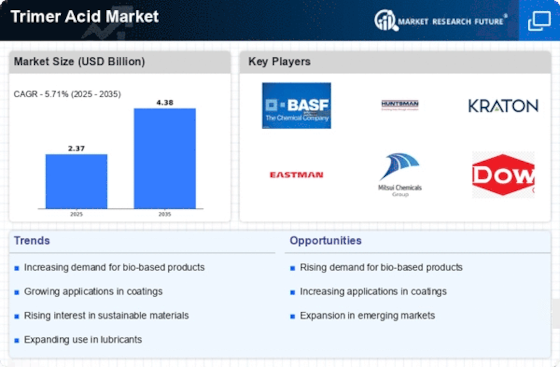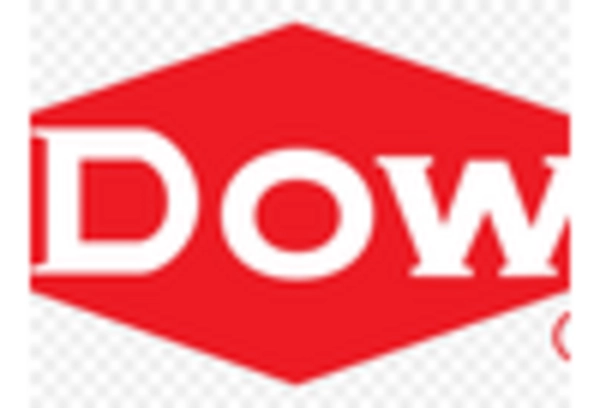Expansion in End-use Industries
The Trimer Acid Market is poised for growth due to the expansion of end-use industries such as coatings, adhesives, and plastics. These sectors are increasingly utilizing trimer acids for their superior properties, including enhanced adhesion, flexibility, and chemical resistance. The coatings industry, in particular, is projected to witness a significant uptick, with a market size expected to reach USD 200 billion by 2026. This growth is attributed to the rising demand for high-performance coatings in automotive and construction applications. Furthermore, the adhesives segment is also expanding, driven by the need for durable bonding solutions in various applications. As these industries continue to evolve, the Trimer Acid Market is likely to benefit from the increasing adoption of trimer acids as essential raw materials.
Rising Demand for Bio-based Products
The Trimer Acid Market is experiencing a notable increase in demand for bio-based products, driven by a growing consumer preference for sustainable and environmentally friendly materials. This shift is largely influenced by heightened awareness of environmental issues and the need for sustainable alternatives to traditional petrochemical products. As a result, manufacturers are increasingly focusing on developing bio-based trimer acids derived from renewable resources. According to recent data, the market for bio-based chemicals is projected to grow at a compound annual growth rate of approximately 10% over the next five years. This trend not only supports the sustainability goals of various industries but also aligns with regulatory frameworks that encourage the use of renewable materials, thereby propelling the Trimer Acid Market forward.
Technological Innovations in Production
Technological advancements in the production of trimer acids are playing a crucial role in shaping the Trimer Acid Market. Innovations such as improved catalytic processes and more efficient extraction methods are enhancing the yield and quality of trimer acids. These advancements not only reduce production costs but also minimize environmental impact, aligning with the industry's sustainability goals. For instance, the implementation of green chemistry principles in the synthesis of trimer acids is gaining traction, leading to more eco-friendly production methods. As a result, manufacturers are better positioned to meet the growing demand for high-quality trimer acids across various applications. This technological evolution is expected to drive the Trimer Acid Market towards greater efficiency and sustainability.
Growing Applications in Personal Care Products
The Trimer Acid Market is witnessing a growing interest in the use of trimer acids in personal care products. These acids are increasingly being incorporated into formulations for their emulsifying and thickening properties, which enhance the texture and stability of various cosmetic products. The personal care industry is projected to reach USD 500 billion by 2027, with a significant portion of this growth attributed to the demand for innovative and effective formulations. As consumers become more conscious of the ingredients in their personal care products, the appeal of trimer acids, which can be derived from natural sources, is likely to increase. This trend not only supports the growth of the Trimer Acid Market but also aligns with the broader movement towards clean beauty and sustainable personal care solutions.
Increasing Regulatory Support for Sustainable Chemicals
The Trimer Acid Market is benefiting from increasing regulatory support aimed at promoting sustainable chemicals. Governments and regulatory bodies are implementing policies that encourage the use of environmentally friendly materials, which is fostering a favorable environment for the growth of trimer acids. For instance, regulations that limit the use of hazardous substances in manufacturing processes are pushing companies to seek safer alternatives, such as trimer acids derived from renewable sources. This regulatory landscape not only enhances the market appeal of trimer acids but also incentivizes manufacturers to invest in sustainable practices. As a result, the Trimer Acid Market is likely to see a surge in demand as companies strive to comply with these regulations while meeting consumer expectations for sustainability.

















Leave a Comment